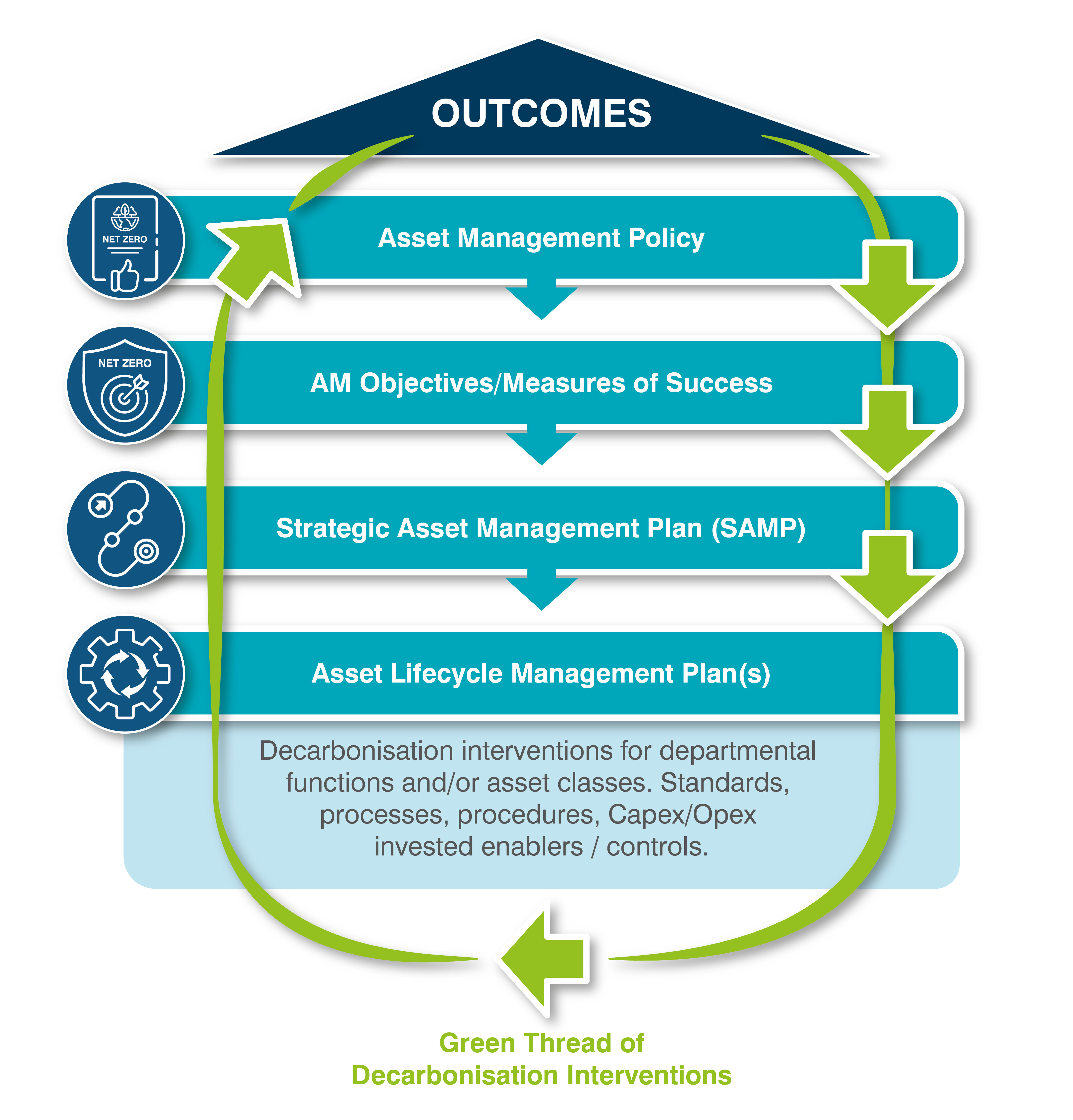
12 June 2023
More and more organisations are maturing their Asset Management approaches by applying ISO 55000 principles and recognised good practice to reach their long-term strategic outcomes or goals. In this context, BMT’s Stephen Hodson and Ewan Glen provide insight into four key strategic enablers to meeting the Greening Government Commitments for 2025 and the ambitious 2050 target for carbon neutrality (Net Zero).
Increasingly, organisations are progressing on their journey of adopting Asset Management good practice in line with ISO 55000 to achieve their desired strategic outcomes or goals. This includes government set targets to reduce emissions by 50% by 2032 with the ultimate ambition of reducing GHG emissions to Net Zero by 2050.
For example, in the public sector, the adoption of ISO 55000 is evident in the highways sector in England, the UK water sector regulatory frameworks and increasingly we are seeing its application in Defence. Several local authorities periodically update their Strategic Asset Management Plans (SAMP) in line with ISO 55000 requirements. For Net Zero, the Cabinet Office is recommending now that all relevant government departments develop their Net Zero strategy and decarbonisation plans as part of a wider SAMP for relevant parts of the government estate.
Asset Management is fundamental to the journey to Net Zero as it concerns aligning business activities and asset investment decisions with desired outcomes so they can be met more effectively, with prioritisation being on a risk / reward basis. Indeed, all assets and the way they are managed, whether they are people, infrastructure, fleet/equipment, land or buildings, have a role in contributing to its achievement.
In line with the international standard there are four key Asset Management enablers which can support the Net Zero journey. They are key, as it is primarily through these that the way an organisation intends to effectively manage its assets to achieve desired is defined.
The Asset Management Policy
A requisite of ISO 55000, the Asset Management Policy sets out the principles and non-negotiable commitments to utilise Asset Management to achieve higher level outcomes. The content communicated through the Policy is essential as it will influence the way asset management activities are carried out now and into the future. Explicitly aligning commitments of the Asset Management Policy to Net Zero is important in providing confidence to relevant stakeholders that there is a clear mandate and consensus on the way forward to achieving it within an organisation. If an organisation’s Asset Management Policy doesn’t really reflect the intentions that the Board/Executive team (Top Management) desire to achieve or are obligated to deliver, then this can create a barrier to real-world decision making and action.
Aligning Asset Management Objectives with the Net Zero Outcome
All functions of an organisation have assets and contribute in varying degrees towards meeting the overall business outcomes, so it is important to ensure that Net Zero is a key consideration within their particular functional or departmental objectives. Setting appropriate sub-targets for particular asset classes is another area being given increased attention by government in relation to its property assets. All of this of course will require robust governance and data collection methods in support of their reportability. In addition to the physical assets, setting objectives for maturing the Asset Management practices themselves (the capabilities or processes) is important to ensure that an organisation is well placed to deliver on Net Zero efficiently and effectively.
The Strategic Asset Management Plan (SAMP)
The long-term strategic plan for the management of assets to meet objectives is set out in the SAMP. The Cabinet Office recognises that one path to meeting Net Zero is to embed decarbonisation within existing strategies for asset management and asset investment programmes for property (land and buildings). The starting point for any strategic plan, or changes made to it, is to undertake a Current State assessment (understand where we are now), then to design a clear vision of the desired Future State (for where we want to get to) followed by a prioritised strategic action plan (for how to get there). In this context, organisations will need to sufficiently orientate the strategic plans for their assets to support the journey to Net Zero if we are to meet it, including having the right mix of strategic initiatives comprised of “low regret” solutions as part of their strategy. These can be prioritised by value for money and the wider social value / emission reduction rewards they bring. In line with ISO 55000, having a systematic, structured process in place for SAMP development is key to aiding that.
Asset Lifecycle Management Plan(s)
Asset Lifecycle Management Plans are typically developed for departmental functions or asset portfolio’s/categories to support the delivery of the SAMP and Asset Management Objectives. The UK government recognises a particular challenge for Whole Life Carbon Assessment methods to support effective planning and decision making over the whole asset lifecycle for its asset portfolio’s which is likely to be a key area of focus in coming years. Another consideration is the advantage of organisations having clearly defined roles and responsibilities over asset lifecycles for carbon reduction. As with cost reduction, the total cost of ownership is heavily influenced by decisions made at the asset creation stage of the lifecycle (i.e. during procurement and design). Decarbonisation is no exception. The decision-making criteria and requirements set at the asset creation stage to aid the decarbonisation effort is an influential factor. Finally, the extent to which carbon reduction interventions are appropriately embedded into asset disposal plans is another important consideration, so that carbon impacts can be minimised efficiently at the end of an asset’s useful life.

As we work towards achieving Net Zero, it is essential that organisations sufficiently orientate their asset management approaches to facilitate the decarbonisation of assets for which they have responsibility.
One way to support the journey to Net Zero is by embedding a cohesive “green thread” of appropriate decarbonisation interventions through Asset Management enablers such as those advocated by ISO 55000. The nature of an organisation’s Asset Management Policy, Asset Management Objectives and the Strategic Asset Management Plans developed now and into the future are key to this.
Although several organisations are developing Asset Management approaches in line with industry recognised good practice, they will inevitably be at different stages of maturity. Many organisations will need to be more innovative and transformative in their approach to enabling Net Zero through their Asset Management arrangements if we are to efficiently and effectively deliver Net Zero.
Would you like to learn more about how we can help your organisation transform? Click below and one of our experts will be in touch!

Stephen is an experienced management consulting professional and works within our Technology & Management Consulting Services Practice, UK & Europe Region. Over his career to date, Stephen has had the opportunity to work within a variety of different departmental functions (policy, strategy & regulation, strategic business planning, capital delivery, governance & internal controls) to support the delivery of business improvements to achieve “Outcomes”. This has included being embedded into client teams as well as working in an advisory role to support their desired strategic asset management transformation and capability.

Ewan is a highly versatile, proactive and experienced management consultant with proven strategic through-life planning and communication skills. He has significant organisational change, design, delivery and assurance experience gained through leading and supporting teams both within Government and industry. Ewan has considerable expertise in capability development drawing together a range of specialisms to support successful business transformation in different contexts. He has worked across different business functions to advise on organisational and programme level improvements to support outcome delivery. Comfortable working to bring clarity where ambiguity and uncertainty prevail by the application of structured management approaches.

N/A
In a world where complexity is the norm and certainty is rare, adaptability isn’t a luxury, it’s a necessity. And when we combine it with empathy, structure, and a commitment to quality, we create programmes that deliver real, lasting value.

Tim Curtis
Most transformation programmes fail—not because of poor execution, but because they never truly understood the race they were competing in. The BMT Strategy Canvas changes that.

Kathryn Walker
Coaching is a proven tool to support change leaders and their teams. The greatest impact and success has been achieved in transformation programmes, where structural and programmatic approaches are supported by attention to the cultural and behavioural aspects of change.

Will Roberts
At BMT, we believe simulation is a critical enabler in overcoming these hurdles—de-risking development, accelerating innovation, and building confidence across the entire lifecycle of autonomous systems.